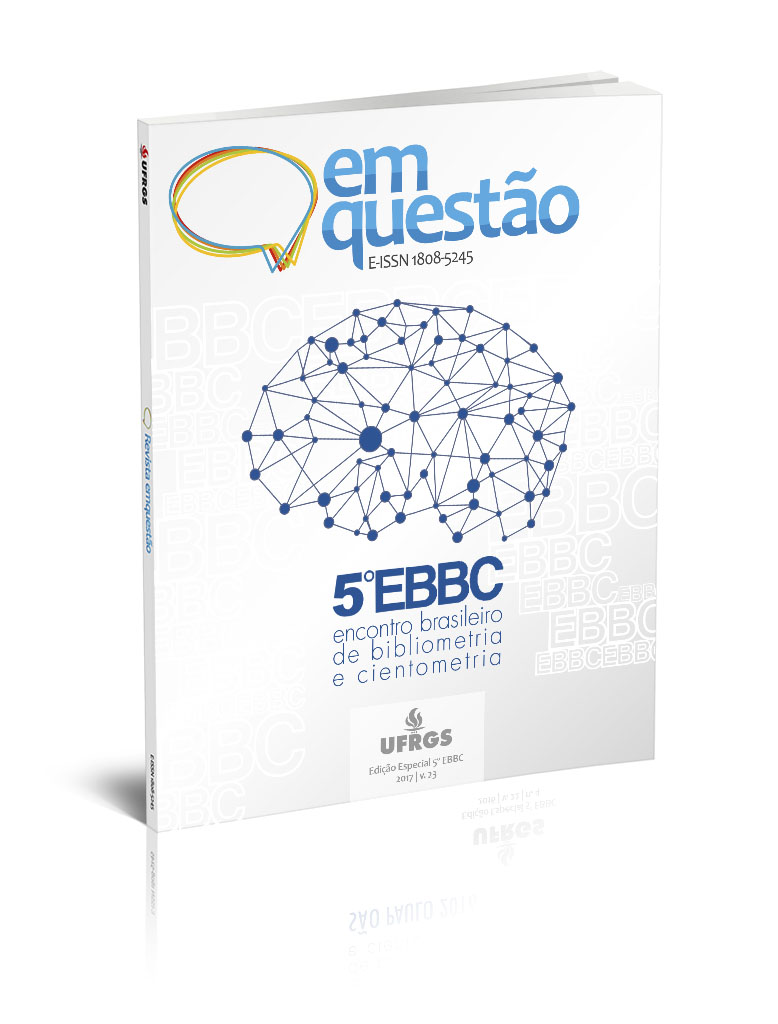Digital Presence in Portals for Journals: Analysis Proposal
DOI:
https://doi.org/10.19132/1808-5245230.159-179Keywords:
Digital presence. Portal for journals. Digital marketing. Open access.Abstract
This research presents an analysis proposal of digital presence — from a theoretical reference of digital marketing — in portals for journals. With the open access movement, the use of electronic journals was intensified in such a manner, that portals for journals also gained more space since its deployment provides strategic issues when contributing to an increased visibility and the public value of the institutions, indicating the quality of the entity, as the latter takes on the responsibility for the preservation and dissemination of the journals, thus contributing to the expansion of scientific communication. Digital marketing has emerged as the application of marketing strategies on the internet or even in the digital environment. The presented proposal tackles the own and the spontaneous presence, not presenting any forms of analysis for the paid digital presence. The proposal is divided in three stages: (1) first stage: identification of the “own digital presence”; (2) second stage: identification of the “spontaneous digital presence”; and (3) third stage: analysis of the data. The mixture of tools, types of methodologies, collections and software point to broader results of the various faces of digital presence, since each has unique characteristics. The methodology presented can be used for diagnosis of the digital presence of portals for journals, pointing out improvements.Downloads
References
ADOLPHO, Conrado. Os 8Ps do marketing digital. São Paulo: Novatec, 2011.
AMERICAN MARKETING ASSOCIATION. Definition of Marketing. 2013. Disponível em: <https://www.ama.org/aboutama/pages/definition-of-marketing.aspx>. Acesso em: 31 maio 2015.
BACK, Caroline. Os 4 pilares do marketing digital.2012. Disponível em: <http://www.ageone.com.br/blog/os-4-pilares-do-marketing-digital/>. Acesso em: 30 dez. 2016.
CORRÊA, Elizabeth Saad. A comunicação digital nas organizações: tendências e transformações. Organicom, São Paulo, v. 6, n. 10/11, p. 162-167, 2009.
COSCELLI, José Geraldo de Barros. Os quatro pilares para ter uma boa presença on-line. [S.l.], 2014. Disponível em: <http://corporate.canaltech.com.br/dica/marketing/Os-quatro-pilares-para-ter-uma-boa-presenca-on-line/>. Acesso em: 19 maio 2016.
FRAGOSO, Suely; RECUERO, Raquel; AMARAL, Adriana. Métodos de pesquisa para internet. Porto Alegre: Sulina, 2011.
GABRIEL, Martha. Marketing na era digital: conceitos, plataformas e estratégias. São Paulo: Novatec, 2010.
GABRIEL, Martha. O impacto da internet nos negócios. 2015. Disponível em: <http://www.adflip.com.br/2015/06/08/o-impacto-da-internet-nos-negocios/>. Acesso em: 19 maio 2016.
GARRIDO, Isadora dos Santos; RODRIGUES, Rosangela Schwarz. Portais de periódicos científicos online: organização institucional das publicações. Perspectivas em Ciência da Informação, Belo Horizonte, v. 15, n. 2, p. 56-72, maio/ago. 2010. Disponível em: <http://portaldeperiodicos.eci.ufmg.br/index.php/pci/article/view/943>. Acesso em: 10 set. 2015.
KOTLER, P.; KARTAJAYA, H.; SETIAWAN, I. Marketing 3.0: as forças que estão definindo o novo marketing centrado no ser humano. Rio de Janeiro: Elsevier, 2010.
LEITE, Fábio Furtado. Presença Digital: uma estratégia de negócios necessária. [S.l.], 2016. Disponível em: <http://www.furtadoleite.com.br/presenca_digital/>. Acesso em: 19 maio 2016.
MARRA, Patrícia; WEITZEL, Simone. Portais de periódicos de acesso aberto nas universidades brasileiras: a utilização do Open Journal Systems. In: ENCONTRO NACIONAL DE PESQUISA EM CIÊNCIA DA INFORMAÇÃO, 16., 2015, João Pessoa. Anais... João Pessoa: UFPB, 2015.
OLIVEIRA, Alexandre P. O sistema das profissões: o trabalho nos Portais de Periódicos. 2012. Artigo apresentado durante o Mestrado em Ciência da Informação do Programa de Pós-Graduação em Ciência da Informação da Universidade Federal de Santa Catarina.
RODRIGUES, Rosângela; FACHIN, Gleisy. Portal de periódicos científicos: um trabalho multidisciplinar. TransInformação, Campinas, v. 22, n. 1, p. 33-45, jan./abr. 2010. Disponível em: <http://periodicos.puc-campinas.edu.br/seer/index.php/transinfo/article/view/483>. Acesso em: 10 set. 2015.
SILVA, Vanessa Bolico da. Marketing digital como ferramenta estratégica e as oportunidades nas redes sociais. E3: Revista de Economia, Empresas e Empreendedores, Souto (Portugal), v. 2, n. 1, p. 25-62, 2016.
STRUTZEL, Tercio. Como a Presença Digital impacta o seu negócio? 29 jan. 2015a. Disponível em: <http://www.terciostrutzel.com.br/como-a-presenca-digital-impacta-o-seu-negocio/>. Acesso em: 26 jun. 2015.
STRUTZEL, Tercio. Os 4 pilares da presença digital. [S.l.], 2013. Disponível em: <http://www.administradores.com.br/artigos/marketing/os-4-pilares-da-presenca-digital/73194/>. Acesso em: 15 maio 2016.
STRUTZEL, Tercio. Presença Digital. Rio de Janeiro: Alta Books, 2015b.
VICENTE, Natalí Ilza. O uso do Twitter e Facebook para divulgação científica: um estudo netnográfico em perfis de bibliotecas universitárias federais do sul do Brasil. 2015. 184 f. Dissertação (Mestrado) - Universidade do Estado de Santa Catarina, Florianópolis, 2015.
WOLCOW, Vitor. Como construir uma presença digital eficiente para o seu negócio. Belo Horizonte, 2015.
Downloads
Published
How to Cite
Issue
Section
License
Copyright (c) 2017 Em Questão

This work is licensed under a Creative Commons Attribution 4.0 International License.
Authors who publish with this journal agree to the following terms:
Authors will keep their copyright and grant the journal with the right of first publication, the work licensed under License Creative Commons Attribution (CC BY 4.0), which allows for the sharing of work and the recognition of authorship.
Authors can take on additional contracts separately for non-exclusive distribution of the version of the work published in this journal, such as publishing in an institutional repository, acknowledging its initial publication in this journal.
The articles are open access and free. In accordance with the license, you must give appropriate credit, provide a link to the license, and indicate if changes were made. You may not apply legal terms or technological measures that legally restrict others from doing anything the license permits.













